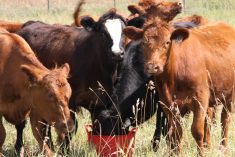GLENLEA, Man. – Marg Rempel stood at the back of the hall feeling economically battered and bruised, but she tried to be hopeful about the future.“I still think farming is the most important vocation in the world and I stand by that,” said Rempel, a farrow-to-finish producer from Ste. Anne, Man., after listening to a recent string of announcements by government and hog industry leaders.“Those of us who are still producing pork still believe we’ll live to see a better day.”However, she admitted it was hard to get excited about the announcements of more than $15 million in spending on hog industry research and quality improvement.She said money for long-term industry development doesn’t seem like a big priority for most producers when life has been a week-by-week challenge and survival until summer has only recently become a viable goal.Canadian Pork Council president Jurgen Preugschas addressed that sentiment as he thanked federal agriculture minister Gerry Ritz for the money.“There are no magic bullets, no one thing that’s going to bring us back to profitability and sustainability,” Preugschas said.“But these building blocks are critical in bringing us, bringing our industry to where it should be as one of the leaders in Canada and certainly in the world.”The federal money will improve research, traceability and quality systems, which Preugschas des-cribed as “important future-facing initiatives.”Manitoba hog producers suffered more extreme disruptions in the hog crisis than their counterparts in other parts of Canada because of their tight connection with the U.S. Midwest.Before country-of-origin labelling was enacted in the United States, Midwest slaughter plants had bought hundreds of thousands of slaughter hogs a year from Manitoba, while millions of Manitoba piglets had been sold annually to Iowa and Minnesota hog feeders.Canadian producers suffered financial losses from an unusually long low in the hog cycle, the H1N1 market slump last spring and the surge in the value of the Canadian dollar.Preugschas said the recent return of profitable hog prices in the United States is raising hopes that those who survived the crisis will be able to rebuild.“We’re desperately in need of some good news and certainly higher prices are the best news of the last couple of weeks,” Preugschas said.“We do see a lot more smiles on producers’ faces than we did last year when we were here in August.”Last August, Preugschas was in the same hall announcing details of the federal emergency aid for the hog industry, which helped some producers quit and others hang on until now. Rempel also attended that announcement, and chose to try to hang on.She’s happy to still be a hog producer but doesn’t know if she was wise to keep losing money through fall and winter so that she can try to rebuild her finances now.“Some days it seems OK, and other days you wonder if you made the right decision.”She is sad about the producers who haven’t survived and don’t have the luxury of wondering whether it was worth surviving.“It’s been hard to see it shrink. We lost a lot of good people. We lost a lot of good human potential.”
Read Also

Organic farmers urged to make better use of trade deals
Organic growers should be singing CUSMA’s praises, according to the Canadian Chamber of Commerce.















